Related Research Articles
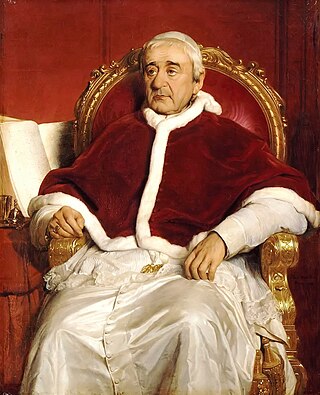
Pope Gregory XVI was head of the Catholic Church and ruler of the Papal States from 2 February 1831 to his death in June 1846. He had adopted the name Mauro upon entering the religious order of the Camaldolese.

Pope Pius VII was head of the Catholic Church from 14 March 1800 to his death in August 1823. He ruled the Papal States from June 1800 to 17 May 1809 and again from 1814 to his death. Chiaramonti was also a monk of the Order of Saint Benedict in addition to being a well-known theologian and bishop.

Pope Pius VIII was head of the Catholic Church and ruler of the Papal States from 31 March 1829 to his death in November 1830.

Christian views on slavery are varied regionally, historically and spiritually. Slavery in various forms has been a part of the social environment for much of Christianity's history, spanning well over eighteen centuries. Saint Augustine described slavery as being against God's intention and resulting from sin. In the eighteenth century the abolition movement took shape among Christians across the globe.
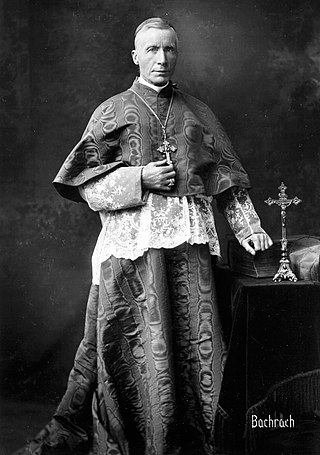
James Cardinal Gibbons was a senior-ranking American prelate of the Catholic Church who served as apostolic vicar of the Apostolic Vicariate of North Carolina from 1868 to 1872, bishop of the Diocese of Richmond in Virginia from 1872 to 1877, and as ninth archbishop of the Archdiocese of Baltimore in Maryland from 1877 until his death.

Humanum genus is a papal encyclical promulgated on 20 April 1884 by Pope Leo XIII.
The history of the Catholic Church is integral to the history of Christianity as a whole. It is also, according to church historian Mark A. Noll, the "world's oldest continuously functioning international institution." This article covers a period of just under two thousand years.
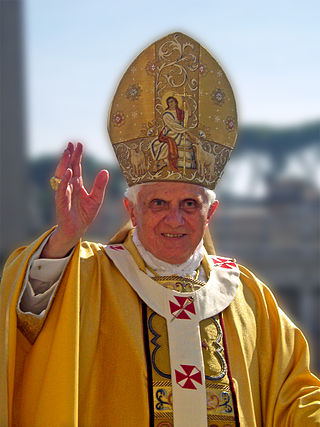
The theology of Pope Benedict XVI, as promulgated during his pontificate, consists mainly of three encyclical letters on love (2005), hope (2007), and "charity in truth" (2009), as well as apostolic documents and various speeches and interviews. Pope Benedict XVI's theology underwent developments over the years, many of which were characterized by his leadership position in the Congregation for the Doctrine of the Faith, which is entrusted with preserving the Catholic faith in its entirety.
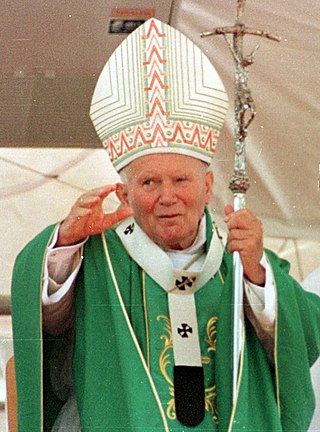
The teachings of Pope John Paul II are contained in a number of documents. It has been said that these teachings will have a long-lasting influence on the Church.

Ineffabilis Deus is an apostolic constitution by Pope Pius IX. It defines the dogma of the Immaculate Conception of the Blessed Virgin Mary. The document was promulgated on December 8, 1854, the date of the annual Solemnity of the Immaculate Conception, and followed from a positive response to the encyclical Ubi primum.

The Catholic Church during the Age of Discovery inaugurated a major effort to spread Christianity in the New World and to convert the indigenous peoples of the Americas and other indigenous peoples. The evangelical effort was a major part of, and a justification for, the military conquests of European powers such as Portugal, Spain, and France. Christian missions to the indigenous peoples ran hand-in-hand with the colonial efforts of Catholic nations. In the Americas and other colonies in Asia, and Africa, most missions were run by religious orders such as the Franciscans, Dominicans, Augustinians, and Jesuits. In Mexico, the early systematic evangelization by mendicants came to be known as the "Spiritual Conquest of Mexico".

Jean Marcel Pierre Auguste Vérot, known commonly as Augustin Vérot was a French-born American prelate of the Catholic Church who served as the first bishop of the Diocese of St. Augustine in Florida (1870–1876).

The Mariology of the popes is the theological study of the influence that the popes have had on the development, formulation and transformation of the Roman Catholic Church's doctrines and devotions relating to the Blessed Virgin Mary.
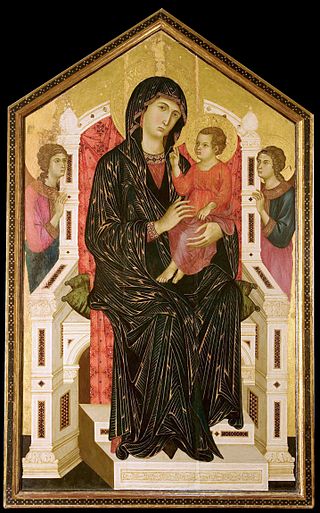
Mariological papal documents have been a major force that has shaped Roman Catholic Mariology over the centuries. Mariology is developed by theologians on the basis not only of Scripture and Tradition but also of the sensus fidei of the faithful as a whole, "from the bishops to the last of the faithful", and papal documents have recorded those developments, defining Marian dogmas, spreading doctrines and encouraging devotions within the Catholic Church.
Ubi primum is an encyclical of Pope Pius IX to the bishops of the Catholic Church asking them for opinion on the definition of a dogma on the Immaculate Conception of the Virgin Mary. It was issued on February 2, 1849.
Apostolatus may refer to :

The Catholic Church and slavery have a long and complicated history. Slavery was practiced and accepted by many cultures and religions around the world throughout history, including in ancient Rome. Passages in the Old Testament sanctioned forms of temporal slavery for Israelites as a means to repay a debt. Slaves, captured in war or purchased, and their children were enslaved for life. After Christianity was legalized under the Roman empire, sentiment grew that many kinds of slavery were incompatible with Christian justice. Views ranged from rejecting all forms of slavery to accepting slavery subject to certain restrictions. The Christian West almost entirely enforced that a free Christian could not be enslaved, for example as a captive in war. However, this was not consistently applied throughout history. The Middle Ages witnessed the emergence of orders of monks such as the Mercedarians who focused on ransoming Christian slaves. By the end of the Medieval period, enslavement of Christians had been largely abolished throughout Europe, although enslavement of non-Christians remained permissible and was revived in Spain and Portugal. Slavery remained a subject of debate within the Church for centuries, with several Popes issuing bulls on the issue, such as Sublimis Deus.
In 1800 the Catholics were a small minority everywhere except Maryland. Immigration from Ireland and Germany gave them millions of adherents from the 1840s to the 1880s. Then came millions more from Italy, Poland and Eastern Europe, as well as French Canada. Large numbers of priests and nuns came from Ireland and France. The Irish soon dominated the clergy church, with a great majority of bishops by 1900. As the immigrants arrived new parishes and diocese were created. Rebuffed in efforts to obtain government funds for schools, the Catholics set up a parochial school system largely staffed with nuns. It reached about a third of the children. They also set up colleges. There were few Catholics in the South, apart from Louisiana. However they were well represented in the nation's cities, mill towns and mining centers. Anti-Catholic politics flared briefly in the 1850s, but the Catholic voters surged into the Democratic Party and Irish Catholic politicians played increasingly dominant roles in Democratic machines in Boston, New York, and other major cities. Devotional practices included daily rosary prayers, regular attendance at Sunday Mass, and special roles for devotion to the Blessed Virgin Mary and favorite saints.
Although many Enlightenment philosophers opposed slavery, it was Christian activists, attracted by strong religious elements, who initiated and organized an abolitionist movement. Throughout Europe and the United States, Christians, usually from "un-institutional" Christian faith movements, not directly connected with traditional state churches, or "non-conformist" believers within established churches, were to be found at the forefront of the abolitionist movements.
References
- ↑ "Pope Gregory XVI 3 December 1839 Condemning Slave Trade" . Retrieved February 16, 2010.
- ↑ Gillis, Chester (1999). Roman Catholicism in America. Columbia University Press. p. 58. ISBN 978-0-231-10871-3.
- ↑ Diène, Doudou (August 2001). From chains to bonds. Berghahn Books. p. 271. ISBN 978-1-57181-266-7.
- 1 2 "In Supremo Apostolatus". Papal Encyclicals Online. 3 December 1839.
- 1 2 Curran, Robert Emmett (2012). Shaping American Catholicism: Maryland and New York, 1805-1915. Print: The Catholic University of America Press. ISBN 978-0-8132-1967-7.
- ↑ Kenrick, Francis (1842). Theologica Moralis. Print: Apud Eugenium Cummiskey.
- 1 2 England, John; Read, William George (1844), "Apostolic Letter of our most holy lord Gregory XVI, by divine providence, pope: Concerning the not carrying on the trade in negroes" (Google books), Letters of the late Bishop England to the Hon. John Forsyth on the subject of domestic slavery: to which are prefixed copies, in Latin and English, of the Pope's Apostolic Letter, concerning The African Slave Trade, with some introductory remarks, etc., Baltimore: John Murphy, pp. ix-xi (& 2 pages before in Latin), retrieved March 17, 2013
- ↑ Geo. Read: Letters to the Honorable John Forsyth, On the Subject of Domestic Slavery Archived 2011-01-04 at the Wayback Machine , December 19, 1843, Jesuit Plantation Project, georgetown.edu
- ↑ "Snipset at Google books" (Google books), Records of the American Catholic Historical Society of Philadelphia, 82–84, American Catholic Historical Society of Philadelphia: 74 (RA1-PA74), 1971, retrieved March 17, 2013
- ↑ In supremo apostolatus, Papal Encyclicals Online